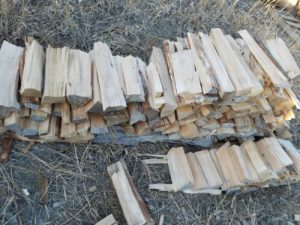Do Willow Trees Produce Good Firewood?
Willow trees are tall, deciduous trees that may reach heights of 30–80 feet and have a spread of 20–35 feet due to their gracefully arching branches. Native to the continents of Europe, Asia, and America, the trees’ wood has been adapted for many applications, including medicine and the manufacture of furniture, crates, and instruments. While its wood is famous for various uses, is it good for firewood?

Is Willow Good for Firewood?
When looking for firewood, willow probably shouldn’t be your first choice. This is because even after seasoning, it produces little heat and burns out fast, like paper. It also produces soot and smokes. However, if you happen to have willow wood just lying around on your property, you shouldn’t let it go to waste. You can split it and let it dry over a few months so that you can use it later as firewood.
Heat Output
The amount of heat an object can provide is its heat output. This is especially crucial when determining whether to use certain woods as fuel.
In the case of willow, it produces 17.6 million BTUs per cord, which is rather low compared to other types of wood. It produces about as much heat as spruce, chestnut, cottonwood, or alder. But less heat compared to hardwoods like Osage orange and oak.
As such, Willow firewood is more preferred for kindling or in the shoulder seasons when it’s not as chilly.
Smoke
Willow produces little smoke, so you don’t have to be too worried when building a fire out of it. Regardless, if you have any breathing complications or allergies, it’s advisable to burn it in an open setting with enough airflow.
Like any kind of firewood, willow wood must be well seasoned before being used. If the wood is green, it means that it still has high water content and will likely produce a lot of smoke when burned. Also, it wastes a lot of energy on pointless processes like evaporating water instead of warming the space.
Sparks
Willow firewood hardly ever sparks or pops. It’s preferable to pine or mulberry, both of which tend to spark a lot. That eliminates the potential for embers to stain the carpet or start an unwanted fire.
Despite willow’s low sparking tendencies, anyone using it for firewood, even in an open area, should be careful. This is because a single spark could start a huge fire.
Coal Production
Another factor that determines whether firewood is desirable is its coaling property. More efficient coaling means the heat will last longer. Another plus is that you won’t have to constantly add wood to the fire.
However, like pine or boxelder, willow burns quickly when used as coal, placing it at the bottom of the rankings. It can’t even be compared to beech or oak, which tend to last longer. In the morning, you’ll have to start again with the fire since the embers will have burned out overnight.
Creosote Buildup
Creosote is a black, tar-like substance that accumulates on the chimney’s inner lining as smoke and embers rise inside the flue.
As long as the firewood has been properly seasoned, it should not generate excessive creosote. Willow emits a lot of creosote while green, but it’s not excessive once it’s completely dry.
How Long Does It Take To Season Willow?
It takes around six months of hot, dry weather for willow to become usable. If you live in a wet, cold area, the wood needs at least a year to dry out. One problem is that it may rot before completely drying out, and as such, it’s recommended that you split it before starting the drying process.
Useful Tips for Seasoning
Try these simple methods to hasten the seasoning of your willow.
- Split the logs: chopping up the wood exposes more of its surface area to air and heat.
- Elevate the wood by stacking cut willow on boards to provide ventilation underneath the stack.
- Use a tarp or cover to protect the firewood from elements such as rain and snow.
- Proper positioning: decrease drying time by avoiding gloomy spots that get no sunshine.
- Create stacks with 3-5″ spacing between each one to improve air circulation.
Is Willow Firewood Expensive?
Willow isn’t a typical furniture wood in the United States, although it seems to be plentiful. Prices are anticipated to be relatively reasonable across its natural range.
Sap Content
All willow species have a lot of watery or milky bark sap. The sap is high in salicylic acid, a plant hormone that aids plants in their defense against diseases. Tree saps high in salicylic acid have long been used to alleviate fever, toothaches, and other types of discomfort. Aspirin, a pain reliever, is derived from salicylic acid extracted from willow bark and leaves.
Burning willow bark with sap isn’t dangerous, but more sap equals more smoke, indicating that the wood needs further seasoning.
How Does Willow Firewood Smell When Burning?
It has been observed that most individuals do not like the smell of burning willow firewood, and some even believe it smells bad. However, the wood heating scale maintained by Utah State University states otherwise, as it rates the scent just mild. Other people generally don’t mind its smell.
Whether or not you find willow appealing depends largely on the variety and your own biases. When burnt, the more common kind, Weeping Willow, releases an odor reminiscent of urine. But red willow has a considerably more pleasing aroma, and when used to smoke meat and fish, it may even give a sweet taste.
How to Distinguish a Willow Tree
Willow trees have many varieties, which all look different; these three are the most commonly known.
Weeping Willow
One of the most easily recognized species, the water-loving weeping willow (Salix babylonica), has a short stem and drooping branches that usually extend to the ground. They may reach heights of 30–70 feet and have long, serrated leaves that are smooth on the underside.
Pussy Willows
Also known as Salix caprea, these are low-lying shrubs that typically top out at about 25 feet in height. The undersides of their leaves are white, and they both have big, fluffy catkins.
Crack Willow
From 50-80 feet in height, the crack willow (Salix fragilis) is easily recognized by its dark brown, highly wrinkled bark. It also has yellow, fragile twigs and 2-to 6-inch-long narrow leaves.
Pros and Cons of Willow Firewood
Pros
- The Red Willow variety, when used to cook meat, brings out a sweet taste.
Cons
- Gives out low amounts of heat
- Produces soot
- Produces smoke
- It burns out quick
Ease of Chopping
Most willow rounds can be easily split with a standard axe and do not need special equipment. Although, wood that has many knots and crotches will be more difficult to split.
If you come across any particularly difficult logs, you may want to put off splitting the wood until a frosty morning, when it’s easier to do so. Using a high-quality splitting axe or maul can also save you time and effort.
Can You Eat the Willow Tree?
While all willows can be eaten, not all of them are tasty. Vitamin C levels in the leaves are seven to ten times higher than in oranges. And many indigenous peoples used to consume the inner bark, but these days nobody seems to bother with the extra effort required.
How Invasive Are Willow Trees?
The robust, intrusive, shallow roots of weeping willow trees may extend up to three times the tree’s height and width (from the trunk to the canopy). The roots of weeping willow trees are also notorious for wreaking havoc on underground infrastructure, including water pipes, sewage pipes, and plumbing.


